

|
| Elliott Sound Products | Counterfeit Semiconductors - 3 |
Last Update - 13 February 2011
 Main Index
Main Index
 Counterfeits Index
Counterfeits IndexUpdate - 21 Feb 2006
I have just been informed by the Australian supplier referred to below that these transistors are also branded as ON-Semi. The only way to be certain is to check the package. Genuine ON devices have square-edged steps on the pins, and (needless to say) have completely flat metal rear surfaces. The fakes have tapered pins and a stepped case as shown in the photo, and non-flat backs (although some may be 'better' than others).
The supplier has issued a recall of the ON branded fakes (having recalled the Motorola branded fakes as soon as they were alerted to the problem), but many constructors may have purchased the fakes before they were identified. If you find any transistors in your collection that look like the fakes shown below, return them immediately.
Update - 08 Jan 2007
A reader contacted me with some further information. He thinks that the reply from ON-Semi was not 100% correct. He has a couple of 25pc tubes of old stock, genuine, Motorola supplied, MJL21193/4 transistors which were bought several years ago through their major Australian distributor. They are date stamped the second and fifth week of 1999 respectively.
This contradicts the information from ON-Semi, which states that the manufacturer of these transistors with the Motorola logo ceased in 1998. The ON-Semi correspondent also states that Motorola hasn't manufactured any semiconductors since 1998. That does not appear to be correct. Motorola was apparently still making PLL ICs and RF power transistors after ON-Semi took over the majority of discrete component manufacture.
Based on this information, don't automatically discard genuine Motorola devices, thinking that they're counterfeit just because of the date code.
The thing that gave the game away with these was the date code. According to the code, they were made by Motorola in 2000, but Motorola had handed all discrete semiconductor manufacture to ON-Semi in 1998, so a Motorola branded part allegedly manufactured after that date cannot possibly be genuine ... or is it?
Further information suggests that even though Motorola spun off the semis as On-Semiconductor, production kept up for a while longer using the old Motorola logo on some of the parts. The last known Motorola part marking is said to be 22 July 2000. Any date code newer than 0028 is obviously a fake. Anything prior to that is questionable.
The same (or similar) fake devices are almost certainly still available in Australia, and can probably be picked simply by the price - I have heard AU$2.50 mentioned for small quantities. Since you can't buy the devices from ON-Semi for that, any MJL21193/4 offered for such a paltry sum is almost certainly counterfeit.
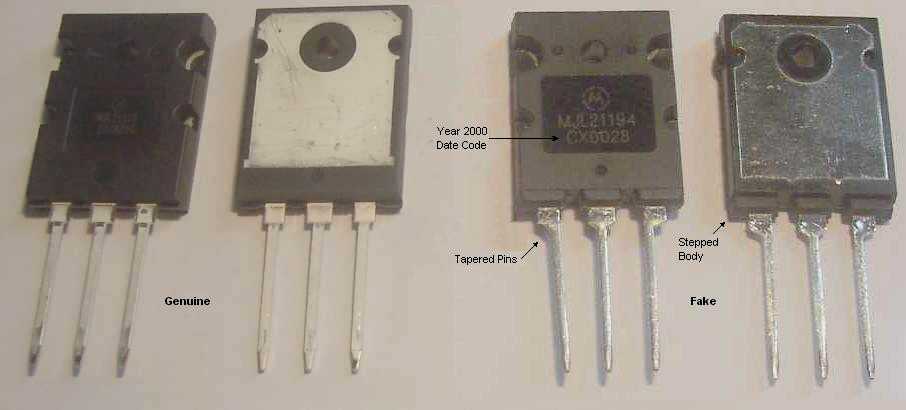
Photo of the Counterfeit 'Motorola' MJL21194 (May Also Be Branded ON ! )
The e-mail exchanges are reproduced below, but as you will see, the supplier name has been removed. I did ask, and was told that they would prefer not to be named, and so shall it be. Likewise, the reader's name is not reproduced.
I have read your article on fake transistors and thought you may be able to shed some light on a possible counterfeit transistor.At this stage, the supplier wasn't overly sympathetic, but things changed quickly. The next part to the story comes from ON-Semi, after they were contacted about the devices. The following reply was forwarded to me ...
I have been working on a project using MJL21193 and MJL21194 transistors and have found what seems to be an anomaly in the packaging. The ON - MJL21193's have come directly from ON-Semi as samples and in all respects conform to the drawings on the data sheet. The Motorola MJL21194's were sourced through (a supplier) and there are some discrepancies between the package and the drawing.
The Motorola data sheet (old version, dated august 31 1995) and the ON data sheet (latest version from on, dated 9 June 2005) both show the same package information, both which match the authentic ON samples.
The suspect devices (see attached image) have steps in the plastic where the legs come out and the outer legs taper towards the center of the package rather that the center of each leg. Also, the heatsink surface is not flat but curved (convex). if I hold two together where they bolt on there is a 0.5 mm gap at the other end (0.25 mm each). The ON devices are dead flat (I cannot see light between two devices held together).
(The supplier) was adamant they get their stock from a large Australian supplier and that they had no concerns. Does this sound like cause for concern or is it normal that a manufacturer would use a different style package and is the flatness of the back of the package an issue? Note that the ON devices are lead-free so the metal finish may be different for that reason and is not necessarily another notable difference.
Response From ON Semiconductor Service Request #66471
ON Semiconductor Technical Information Center
Thank you for contacting ON Semiconductor
This device does not match our packaging and marking specifications. It is not ON Semi's or Motorola's device, because there is the year of production: 2000. ON Semi had take over the portfolio from Motorola in 1998. Also Motorola is not producing any semiconductors from this date, only whole electrical appliances.
Regards,
ON Semiconductor
Technical Information Center
I contacted the supplier and passed on the concerns as soon as I had confirmation that the devices were counterfeit. Later that same day I was able to confirm that all stores were instructed to check existing stock and return any fake devices to the warehouse.
Note the update above though - it seems that ON-Semi may be a little confused as to the actual date codes and the date that Motorola branding ceased.
The next batch of fakes are not marked as Sanken, but use the same type number as a Sanken transistor. While this does not make them (technically) counterfeits, they are still fraudulent. A transistor marked as a specific type should perform to a similar standard as the original, and this is very common with a lot of 'second sourced' components. This is where more than one manufacturer makes the same type number. In general, these second sourced devices can be expected to perform as well as the original.
That was definitely not the case with these devices. They are branded as 'IEC', but don't be surprised if this is not a known semiconductor supplier. There was nothing in the information I was given to indicate that the complement was also available as an 'IEC' device, but it is safe to assume that it will be in circulation.
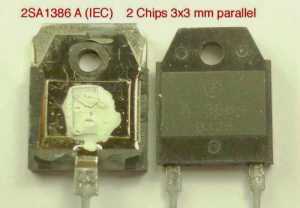
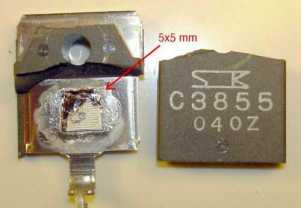
Photos of the IEC 2SA1386 (Left) and for comparison, Sanken 2SC3855 (Right)
The original message I received on this topic came from Germany, but beware of these devices regardless of where you are ...
Hi Rod,
there are not many sites dealing with counterfeit transistors. great!
recently I ran into some transistors made by IEC which weren't that wonderful, at least they haven't been relabeled SANKEN.
The original SANKEN 2SA1386 is rated 130Watt with a SOA of 1,5A @ 60V continuous - The IEC survived a 1A 60V pulse of 1 sec.
When I tried it with 1,5A @60V it died after 0.4sec. Case temperature was only 20 (Celsius).
When I opened the case I saw that it has two dies parallel, each about 3 mm square, total area is 18 sqmm.
For comparison, The smaller SANKEN 2SC3855 (100W) has already a die of 5x5 mm = 25sqmm.
If you like you may put the pictures in your gallery, though these types are not used in your projects.
What we see here is a flat-pack version of the 'double-headed duds' described first for the MJ15003/4. This is the first time I have seen this done in a plastic package, and was obviously an attempt to make the transistors perform to some standard. Needless to say it failed. The smaller Sanken device (2SC3855) is not the complement to the 2SA1386 (that is the 2SC3519), but was included as a comparison - a smaller transistor with a bigger die area than one supposedly rated for higher power. Need we say more?
It's a very sad situation, but as I have mentioned elsewhere in this section, I consider it unwise to buy any Japanese transistors unless you are 100% certain of their pedigree. Whoever is doing the counterfeiting seems to have targeted the Japanese devices hard, and they won't stop now.
Please find attached email with pictures of possible Sanken fakes. I bought these in the UK and were assured they were genuine, however i don't think they are - markings are different, shiny surface on the back, slightly smaller case etc. I opened one of the devices and also a real one this is what I found. It's very similar Internally to the 2SA1216s already on your page.
The right hand side of each photo is the Genuine device, left hand the fake.

Photos of the Fake (Left) and Real (Right) 2SC2922 Transistors
The difference is subtle, and picking the real from the fake in isolation would be rather difficult.
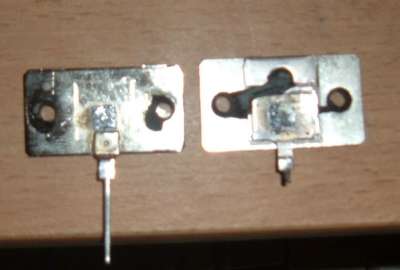
Dies in the Fake (Left) and Real (Right) 2SC2922
The die size difference is quite obvious, and it is apparent that the fake will be unable to perform at the rated power level because the die is so small.
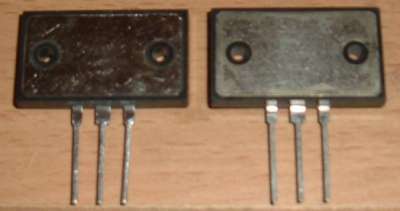
Rear View of the Packages of the Fake (Left) and Real (Right) 2SC2922
I have no additional information about these, and as always, the info is presented here to advise people that fake 2SC2922 transistors exist. The 2SA1216 has already been identified (see 2SA1216 for description and photos). Naturally, if one polarity of fake exists, we can expect that the other also exists within the same device family.
The following photos show a new batch of fakes. The die size is way too small, and the fakes failed to meet their VCEO (collector-emitter breakdown voltage with base open) specifications (see below for details). While it is unlikely that hobbyists will use these transistors, they are used in equipment made by the correspondent who sent them to me. Note that there is evidence of editing on each of the pix - this is not to artificially create images, but to clarify the images, and in one case to remove artefacts that were on the originals.
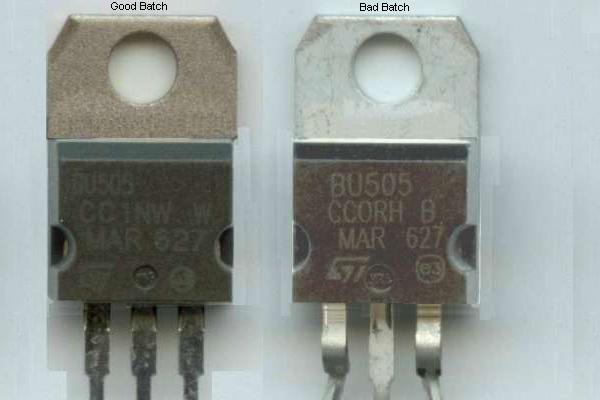
Photos of the Real (Left) and Fake (Right) BU505 Transistors
Image editing was done to remove artefacts from the originals and reduce the size. The transistor images are otherwise as supplied.
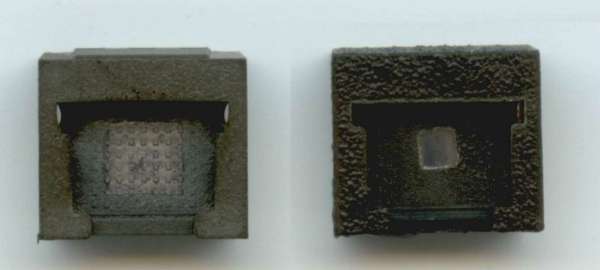
Photos of the Real (Left) and Fake (Right) BU505 Dies
In the photo above, the metal parts had been etched away using acid to leave the epoxy case and silicon die.
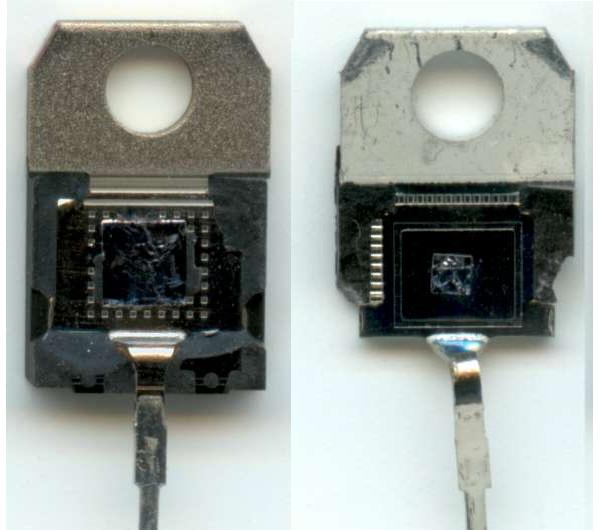
Photos of Real (Left) and Fake (Right) MJE8502 Dies
In the second two photos, the tiny die in the fakes is immediately obvious. While the die size does not affect the breakdown voltage (this is the result of the die processing), it seriously affects the power handling. With high voltage transistors, considerable power may be dissipated even at relatively low current. We can be certain that both ST and On-Semi (or Motorola) made the die the size required for the application.
My correspondent writes ...It is likely this won't affect many, but we have good evidence of counterfeit high voltage transistors from some suppliers. The types so far affected are BU505 and MJE8502, these are 1500V VCES and 700V VCEO. We noted failures in our products and traced to a very low VCEO which I checked with a current limited voltage source. We found ST brand BU505's failing at slightly more than 500V VCEO and the same for Onsemi branded MJE8502. I etched a couple of BU505's with nitric acid to remove all metal. One was a good tested one and one the other a failed one. There was a completely different die size between the two. The good one had a 3.3mm die and the bad one a 1.8mm die. The good one had the markings etched and the bad one had markings printed. These devices are often used for switchmode supplies and horizontal drive in CRT's, where circuit designs may not ever allow the base to be open circuit, ie driven from a low impedance source, so I guess that many users many not see the failures.
I presented the data to St Microelectronics and they confirmed the likelihood of counterfeit devices. Now we will have to do incoming VCEO checks of all batches until the situation improves. We try to get these normally from mainstream suppliers, but sometimes supply problems prevent this. Looks like we will have to get smarter with purchasing though. This is the first time I have personally come across this in 20+ years of engineering.
The MJE8502 are obsolete, but it seems to me more likely that these devices are a problem because companies desperate to keep their products shipping will try to get them from secondary suppliers. The BU505 are not obsolete but only available from ST microelectronics. As you may be aware, there is not much choice in high voltage bipolar transistors.
Below is the contents of an email I sent to a blogger in the USA ...
Sure, you can use my data in your blog. That's an interesting story about how one of your engineers found the suspect IC. My experience was similar. Our design had worked for 20 years in the field, then suddenly last year we had failures. My gut reaction was counterfeiting, even though I had never experienced it before, and this was without even laying a CRO probe on the circuit.
A month ago, me and our RF engineer looked into it, wondering what was wrong with the design. After a week of bench tests and simulations we went back to basics. We measured the VCEO and found the problem! When I etched the metal from some samples, we found a tiny die on the faulty parts. This occurred with ST BU505's and some OnSemi MJE8502's, though these are obsolete.
Our purchasing people are sometimes forced to use buying houses for obsolete stock. Also, because we are low volume, the MOQ's and lead times are real pain so they buy from less reputable sources. In this case we found it but I don't know what we will do in all future cases, since we can't re-design everything to use the latest parts. BTW, the ST BUL416s worked well (reputable supplier) but the measured VCEO was no better than standard BU505's which are rated 700 volts, the BUL416 being 800V.
Now you probably would like to know the distributors we used, I'll leave it up to you but I imagine you may not want to mention their names for litigation reasons. The companies we had trouble with were ( ... 3 supplier names are indeed suppressed since I can't afford expensive lawsuits). We have had so many rejected batches though that we can't now be sure without serious investigation which company supplied what. We won't be doing such investigation though, as far as we are concerned we just need to but from reputable sources. It is worth noting that we have not had problems so far from distributors such as Arrow and Farnell. Our purchasing has been reluctant to buy from some distributors though, as MOQ's of 50000 and 16 week lead times are hard to manage. We only use about 5000 of these devices per annum.
Below is my [edited by ESP] correspondence with ST.
Question : In recent batches we have had ST BU505's and production failures. We have done further testing and have discovered the failing transistors fail the VCEO test at 150-200 volts less than the manufacturers spec of 700 Volts. Some older Philips and ST batches consistently pass this test. I have etched 2 ST BU505 transistors to remove all metal and leave only silicon and encapsulation behind. There is a large difference in die size between the failing batch and the passing batch. The difference correlates to the failures we are having. The small die breaks down at a little over 500 volt VCEO tested with a current limited power supply set to 2 mA, the die size is about 1.8mm. The good transistor achieves over 1000 volt VCEO and die size is about 3.3mm. We since have found that the ST transistor BUL416 works well in this application too. Also, a recent batch of BU506 from ST yielded similar problems. Our Malaysian plant is also reporting failures with these transistors. The good transistor is marked: BU505 CC1NX W MAR 626 ST symbol lower left printing appears to be etched The failing transistor is marked: BU505 CC0PH 8 MAR 627 ST symbol lower left printing appears to be printed We would like to determine your opinion and if there is a possibility of counterfeiting of these devices.
The reply from ST indicated that they were fairly certain that the parts were fakes, and requested further information from the ST distributor (if the parts were obtained from an 'official' source).
As you can see from the above, not only hobbyists and large corporations are at risk. Small-medium manufacturers (especially for niche and/or specialty industrial products) are a great risk, and the impact of fake semiconductors has a profound effect on the viability of the company. In extreme cases, a large shipment of fake devices can cause huge problems if not found quickly. Returned goods, lost profits, loss of customer confidence, possible bad press coverage and the costs associated with making good the problems can be more than a company can bear.
There was an informative document published by the IEEE - it's not recent, and because it might be very hard to find I have a copy available HERE for reference. Over the past few years, there has been a great deal more publicity about fake goods of all types. This is not only to protect the brands that suffer as a result of the fakes, but to alert consumers that this is a common practice.
Not that some consumers are too concerned that they are supporting criminal activity. If you see famous name products (denim jeans, running shoes, handbags, sunglasses, etc.) for 1/10th of their normal price, you have to know they are fakes. Major on-line auction sites pay lip-service to the fight against fakes. They claim to "take all matters of copyright infringement and counterfeit goods very seriously", but as many have found out this is complete bull***t. They completely ignore the thousands of fakes that are for sale every day, just as they ignore dangerous electrical products (fake electrical safety switches, unapproved power outlets - the list is endless).
I have recently found products sold by supposedly legitimate companies, who have completely failed to obtain any Australian approvals for products sold. Some approvals are just paperwork, but others are far more serious. For example, plug-pack (wall-wart) power supplies are prescribed items in Australia, and are subject to mandatory electrical safety tests and appropriate labelling to show compliance. While I accept that the risk of catastrophic failure is low, the units supplied did not comply with Australian MEPS (Minimum Energy Performance Standards), and since I could not even find a maker's name on the plug-packs, I have no idea if they are made to worldwide safety standards or not.
It is quite true that these products are not counterfeit as such, but are simply an example of the ease with which this can be done. It would have been simple to apply a label with a bogus Australian approval number and no-one would be the wiser. After that, the product is counterfeit, as it purports to be something it's not and have approvals that are faked.
This problem shows no sign of abating, and I fully expect it will get much worse before it gets better. I urge you to read the IEEE Bogus report. It was published in 2006, but since then not one thing mentioned has improved, and most are worse.
 Main Index
Main Index
 Counterfeits Index
Counterfeits Index